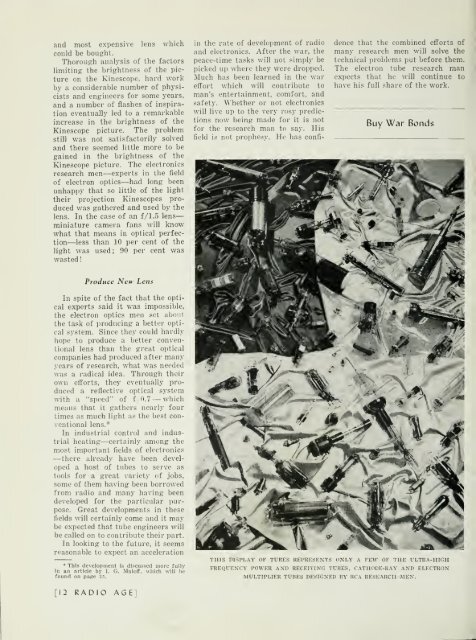Radio Age - 1944, January - 36 Pages, 3.3 MB ... - VacuumTubeEra
Radio Age - 1944, January - 36 Pages, 3.3 MB ... - VacuumTubeEra
Radio Age - 1944, January - 36 Pages, 3.3 MB ... - VacuumTubeEra
Create successful ePaper yourself
Turn your PDF publications into a flip-book with our unique Google optimized e-Paper software.
and most expensive lens which<br />
could be bought.<br />
Thorough analysis of the factors<br />
limiting the brightness of the picture<br />
on the Kinescope, hard work<br />
by a considerable number of physicists<br />
and engineers for some years,<br />
and a number of flashes of inspiration<br />
eventually led to a remarkable<br />
increase in the brightness of the<br />
Kinescope picture. The problem<br />
still was not satisfactorily solved<br />
and there seemed little more to be<br />
gained in the brightness of the<br />
Kinescope picture. The electronics<br />
research men—experts in the field<br />
of electron optics^had long been<br />
unhappy that so little of the light<br />
their projection Kinescopes produced<br />
was gathered and used by the<br />
lens. In the case of an f/1.5 lens<br />
miniature camera fans will know<br />
what that means in optical perfection—less<br />
than 10 per cent of the<br />
light was used; 90 per cent was<br />
wasted<br />
in the rate of development of radio<br />
and electronics. After the war, the<br />
peace-time tasks will not simply be<br />
picked up where they were dropped.<br />
Much has been learned in the war<br />
effort which will contribute to<br />
man's entertainment, comfort, and<br />
safety. Whether or not electronics<br />
will live up to the very rosy predictions<br />
now being made for it is not<br />
for the research man to say. His<br />
field is not prophesy. He has confidence<br />
that the combined efforts of<br />
many research men will solve the<br />
technical problems put before them.<br />
The electron tube research man<br />
expects that he will continue to<br />
have his full share of the work.<br />
Buy War Bonds<br />
Produce New Lens<br />
In spite of the fact that the optical<br />
experts said it was impossible,<br />
the electron optics men set about<br />
the task of producing a better optical<br />
system. Since they could hardly<br />
hope to produce a better conventional<br />
lens than the great optical<br />
companies had produced after many<br />
years of research, what was needed<br />
was a radical idea. Through their<br />
own efforts, they eventually produced<br />
a reflective optical system<br />
with a "speed" of f/0.7 — which<br />
means that it gathers nearly four<br />
times as much light as the best conventional<br />
lens.*<br />
In industrial control and industrial<br />
heating—certainly among the<br />
most important fields of electronics<br />
—there already have been developed<br />
a host of tubes to serve as<br />
tools for a great variety of jobs,<br />
some of them having been borrowed<br />
from radio and many having been<br />
developed for the particular purpose.<br />
Great developments in these<br />
fields will certainly come and it may<br />
be expected that tube engineers will<br />
be called on to contribute their part.<br />
In looking to the future, it seems<br />
reasonable to expect an acceleration<br />
• This development is discussed more fully<br />
Id an article by I. G, MalofT, wliicli will be<br />
found on pag« 25.<br />
":^P%Sl\b^<br />
Tins DISPLAY OF TUBES REPKESKNTS ONLY A FEW OF THE VLTRA-HIGH<br />
FHEQUENCY POWER AND RECEIVING TUBES, CATHODE-RAY AND ELECTRON<br />
MULTIPLIER TUBES DESIGNED BY RCA RESEARCH .MEN.<br />
[12 RADIO age;
















